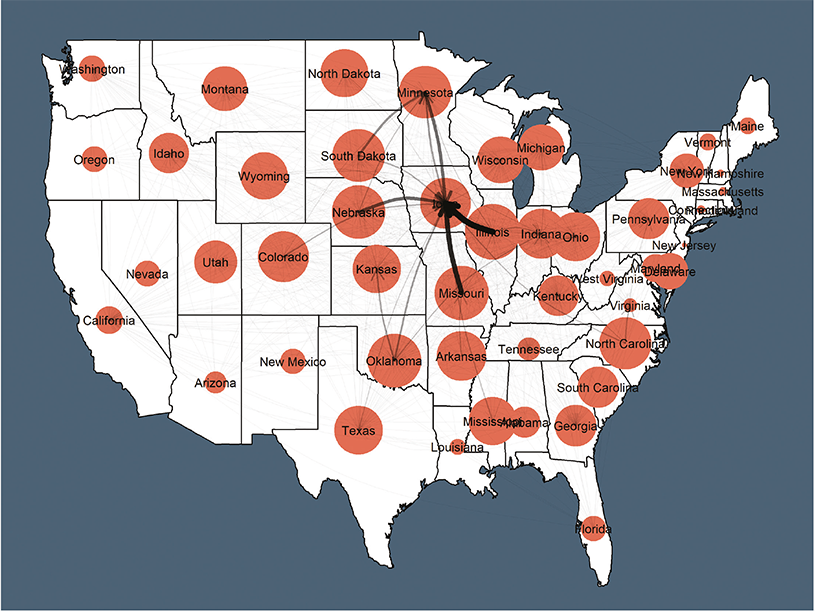



AASV: Interstate swine movement can predict pathogen spread
Illinois, Minnesota, Missouri and Nebraska could be considered extremely high priority states for disease mitigation(Excerpts of a presentation by Megan Thomas and colleagues, Iowa State University and National Animal Disease Center, Ames, Iowa, during the 2024 conference of the American Association of Swine Veterinarians)
Prior research conducted at a regional level demonstrated that swine pathogen spread was highly associated with pig movement. However, it is difficult to estimate how a pathogen emerging in one state will move across the country and, hence, which areas to target for restricted movement of swine in an effort to mitigate the spread of disease.
State-level data was used to create a national network of interstate swine movement. This network was evaluated as an informative predictor of the spread of disease, using the porcine reproductive and respiratory syndrome virus (PRRSV) L1C 1-4-4 variant as a test case.
Hog import records were collected from 2020 - 2022 from 27 US states. Data collection was prioritized from states with the largest hog inventory or significant interstate transport. The three years were chosen due to the relative ease of access to records following the adoption of electronic certificate of veterinary inspection (CVI) databases by the majority of states.
Approximately 95% of annual interstate swine transport was represented in this study: 55.4 million out 58.3 million total head, as reported by the USDA in 2021.
Interstate swine transport
All PRRSV L1C 1-4-4 variant sequences and metadata (n = 3,645) from 2020 to August 2023 were collected from a regional diagnostic lab. Interstate swine imports and exports were reflected by in- and out-strength centrality measures. Illinois, Missouri, Oklahoma, Nebraska and South Dakota exported the most pigs in 2021 (Figure 1).
Iowa, Minnesota, Indiana, Kansas, and Missouri imported the most pigs in this same time frame. The number of pigs imported had a stronger association with the total hog census than the number of pigs exported. Six states (Kansas, Virginia, North Dakota, California, Georgia, and Idaho) ranked disproportionately high on imports relative to their total hog census. These states have the potential to contribute more to disease spread than their census numbers alone would typically suggest.
Authority and hub centrality
“Authority centrality” considers a state’s significance based on the importance of states it is connected to (via hog import/export) and the number of pigs imported into it. “Authorities” have relatively high incoming traffic, thus the three states with the highest authority were also the three states that imported the most hogs (Iowa, Minnesota and Indiana). These states are particularly susceptible to a pathogen being transmitted into their borders.
“Hub centrality” measures the degree to which a state connects highly important locations in the network. Which states it connects to and the number of pigs moved between them are taken into consideration. Pathogens are likely to quickly spread from hubs to highly populated neighboring states. Illinois, Missouri, and Nebraska were recognized as the most important hubs in the network.
Four states (Illinois, Minnesota, Missouri, and Nebraska) were ranked in both the top ten of both hubs and authorities. Iowa, despite being the most hog dense state in the country, does not export a proportionate number of pigs and thus is not considered a significant hub. Thus, in this network, Iowa has the highest risk of disease entering the state, but lower risk of disease leaving the state. The state of Virginia also had similar dynamics in this network.
Predicting PRRS diffusion
The interstate swine transport network was tested for its predictive value in PRRSV L1C 1-4-4 variant spatial diffusion. The transport network was highly correlated with interstate spread of the PRRS L1C 1-4-4 variant. These results demonstrate that an interstate swine transportation network has important implications for national preparedness for a foreign animal disease (FAD) outbreak that could likely spread with animal movement.
States with high “authority centrality,” most notably Iowa, will have an extremely high risk of the pathogen entering their borders. States that are major hubs present a risk to key hog production states. These states could be some of the best targets for interventions focused on slowing the spread of a pathogen.
Illinois, Minnesota, Missouri and Nebraska could be considered extremely high priority states for disease mitigation because they rank in the top 10 states as receivers and donors of emerging pathogens.

Figure 1: Interstate swine transportation network. Black lines are weighted by the number of pigs moved from one state to another annually (arrowhead). The size of the state circles (salmon) are scaled by log2 of the total pigs exported by the state annually.









